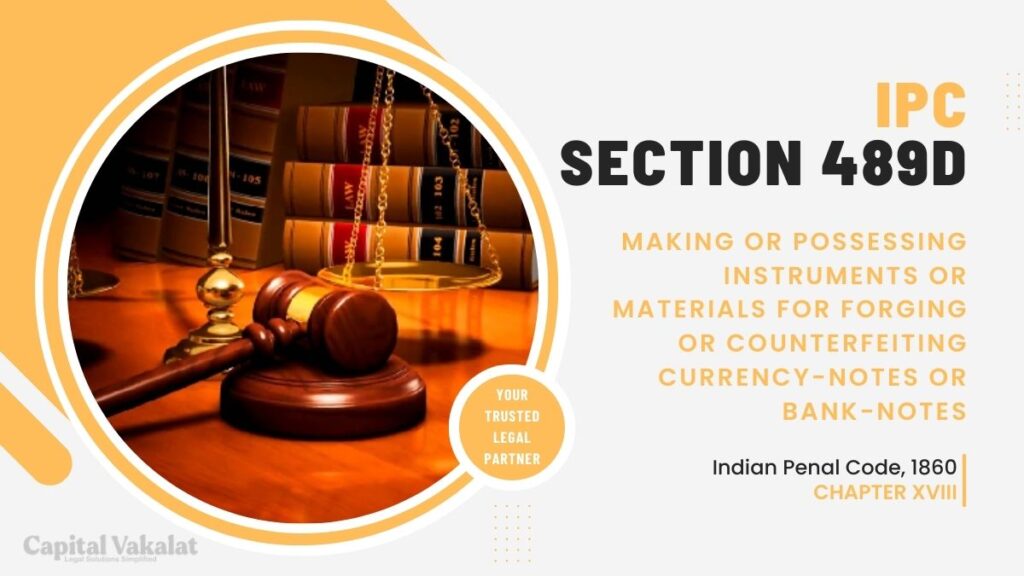Counterfeiting currency notes is a serious offense that undermines the stability of financial systems and poses a threat to the economy. Section 489D of the Indian Penal Code (IPC) specifically addresses the making or possessing of instruments or materials for forging or counterfeiting currency-notes or bank-notes.

Understanding the intricacies of this section is crucial to comprehend the legal implications associated with such activities.
Understanding Section 489D IPC
Section 489D of the IPC is designed to curb the creation and possession of tools and materials used in the illegal act of forging or counterfeiting currency notes. The section outlines the specific elements that constitute an offense and establishes the legal consequences for those found guilty of violating its provisions.
Making Instruments for Forging Currency Notes
The term “making” within the context of Section 489D refers to the process of creating instruments that can be used in forging currency notes. These instruments encompass a range of tools and devices that have the potential to replicate or imitate genuine currency. Examples include printing plates, holograms, and specialized inks designed to mimic security features.
Possessing Instruments for Forging Currency Notes
Possession of instruments or materials for forging currency notes is a separate offense under Section 489D IPC. Merely having these tools, even without actively using them, is considered a violation. The law defines the materials that fall under this category and specifies the circumstances under which possession becomes a criminal act.
Significance of Forging or Counterfeiting Currency
The consequences of forging or counterfeiting currency extend beyond legal implications. Such activities can have a detrimental impact on the economy, leading to a loss of confidence in the financial system. The risks associated with counterfeit currency include inflation, loss of purchasing power, and potential damage to the country’s reputation in the global market.
Evolution of Laws Against Counterfeiting
The legal framework surrounding counterfeiting has evolved over the years to keep pace with advancements in technology and changing criminal tactics. Historical context sheds light on the development of anti-counterfeiting laws, with amendments made to address emerging challenges.
International Perspectives on Counterfeiting
A comparative analysis of anti-counterfeiting laws across different countries provides insights into global efforts to combat this illicit activity. Understanding how other nations approach the issue can inform the enhancement of domestic legislation and international collaboration in tackling counterfeiting.
Challenges in Enforcing Section 489D IPC
Enforcing Section 489D poses several challenges for law enforcement agencies. The clandestine nature of counterfeiting operations, coupled with the use of sophisticated technologies, makes it difficult to detect and prosecute offenders. Technological advancements, while aiding law enforcement, also present challenges in staying ahead of counterfeiters.
Preventive Measures and Public Awareness
Preventing counterfeiting requires a multifaceted approach involving legislation, technology, and public awareness. Implementing robust security features in currency notes, educating the public on how to identify genuine currency, and encouraging reporting of suspicious activities are essential components of a comprehensive strategy.
Conclusion
In conclusion, Section 489D IPC plays a vital role in deterring the making and possession of instruments for forging currency notes. Its significance goes beyond legal consequences, impacting the economic stability of a nation. As technology continues to advance, it is imperative to revisit and update anti-counterfeiting laws to stay ahead of evolving criminal tactics. Public awareness and cooperation are equally crucial in the collective effort to combat the threat of counterfeit currency.
Frequently Asked Questions
What are the common materials used in forging currency notes?
Materials such as printing plates, specialized inks, and holograms are commonly used in forging currency notes.
How can individuals protect themselves from counterfeit currency?
Vigilance is key. Individuals should familiarize themselves with the security features of genuine currency and report any suspicious notes to the authorities.
What role does technology play in combating counterfeiting?
Technology is both a challenge and a solution. While it facilitates counterfeiting, advancements in technology also enable the development of sophisticated anti-counterfeiting measures.
Are there international collaborations to address counterfeiting?
Yes, many countries collaborate to share information and strategies in the fight against counterfeiting. International cooperation is crucial to combat this global threat.